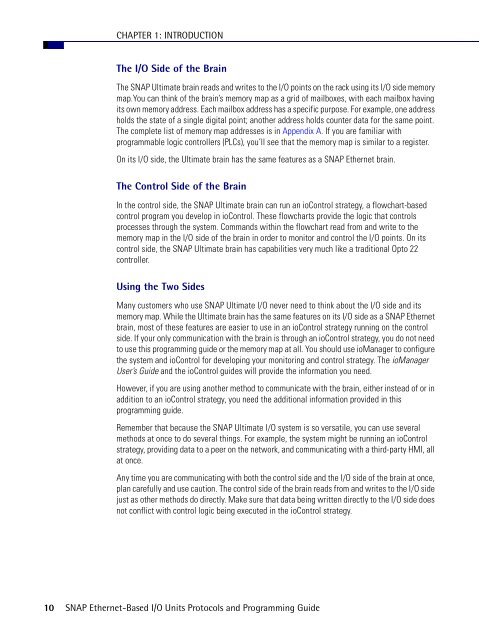snap ethernet-based i/o units protocols and programming guide
snap ethernet-based i/o units protocols and programming guide
snap ethernet-based i/o units protocols and programming guide
You also want an ePaper? Increase the reach of your titles
YUMPU automatically turns print PDFs into web optimized ePapers that Google loves.
CHAPTER 1: INTRODUCTION<br />
The I/O Side of the Brain<br />
The SNAP Ultimate brain reads <strong>and</strong> writes to the I/O points on the rack using its I/O side memory<br />
map.You can think of the brain’s memory map as a grid of mailboxes, with each mailbox having<br />
its own memory address. Each mailbox address has a specific purpose. For example, one address<br />
holds the state of a single digital point; another address holds counter data for the same point.<br />
The complete list of memory map addresses is in Appendix A. If you are familiar with<br />
programmable logic controllers (PLCs), you’ll see that the memory map is similar to a register.<br />
On its I/O side, the Ultimate brain has the same features as a SNAP Ethernet brain.<br />
The Control Side of the Brain<br />
In the control side, the SNAP Ultimate brain can run an ioControl strategy, a flowchart-<strong>based</strong><br />
control program you develop in ioControl. These flowcharts provide the logic that controls<br />
processes through the system. Comm<strong>and</strong>s within the flowchart read from <strong>and</strong> write to the<br />
memory map in the I/O side of the brain in order to monitor <strong>and</strong> control the I/O points. On its<br />
control side, the SNAP Ultimate brain has capabilities very much like a traditional Opto 22<br />
controller.<br />
Using the Two Sides<br />
Many customers who use SNAP Ultimate I/O never need to think about the I/O side <strong>and</strong> its<br />
memory map. While the Ultimate brain has the same features on its I/O side as a SNAP Ethernet<br />
brain, most of these features are easier to use in an ioControl strategy running on the control<br />
side. If your only communication with the brain is through an ioControl strategy, you do not need<br />
to use this <strong>programming</strong> <strong>guide</strong> or the memory map at all. You should use ioManager to configure<br />
the system <strong>and</strong> ioControl for developing your monitoring <strong>and</strong> control strategy. The ioManager<br />
User’s Guide <strong>and</strong> the ioControl <strong>guide</strong>s will provide the information you need.<br />
However, if you are using another method to communicate with the brain, either instead of or in<br />
addition to an ioControl strategy, you need the additional information provided in this<br />
<strong>programming</strong> <strong>guide</strong>.<br />
Remember that because the SNAP Ultimate I/O system is so versatile, you can use several<br />
methods at once to do several things. For example, the system might be running an ioControl<br />
strategy, providing data to a peer on the network, <strong>and</strong> communicating with a third-party HMI, all<br />
at once.<br />
Any time you are communicating with both the control side <strong>and</strong> the I/O side of the brain at once,<br />
plan carefully <strong>and</strong> use caution. The control side of the brain reads from <strong>and</strong> writes to the I/O side<br />
just as other methods do directly. Make sure that data being written directly to the I/O side does<br />
not conflict with control logic being executed in the ioControl strategy.<br />
10 SNAP Ethernet-Based I/O Units Protocols <strong>and</strong> Programming Guide
















